Bert's Town - Part 04 - Contrasts
w/e 24 May 2009
All this week's pictures were taken
with a Kodak DX6490

 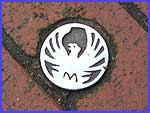 Part 03 ended
with a brief detour from the Blue Line Trail to take in the third
plaque on the D. H. Lawrence Literary Trail outside the Sun Inn
but on entering Nottingham Road the two trails come together
again. The Literary Trail is indicated by small phoenix symbols
(left) embedded into the footpath. The discs measuring approximately
3 inches in diameter are not as easy to follow as the painted
blue line but they link the larger plaques which here, are on
both sides of Nottingham Road. The fifth literary plaque is to
be found outside the Bombay Spice Restaurant and Takeaway (right),
a far cry from when Bert was a boy in the town and a butcher
traded from the shop as he later recalled in 'The Lost Girl':
"The curtain was down... it represented a patchwork of
local adverts. There was a fat porker and fat pork-pie, and the
pig was saying 'You all know where to find me. Inside the crust
at Frank Churchill's.'" Part 03 ended
with a brief detour from the Blue Line Trail to take in the third
plaque on the D. H. Lawrence Literary Trail outside the Sun Inn
but on entering Nottingham Road the two trails come together
again. The Literary Trail is indicated by small phoenix symbols
(left) embedded into the footpath. The discs measuring approximately
3 inches in diameter are not as easy to follow as the painted
blue line but they link the larger plaques which here, are on
both sides of Nottingham Road. The fifth literary plaque is to
be found outside the Bombay Spice Restaurant and Takeaway (right),
a far cry from when Bert was a boy in the town and a butcher
traded from the shop as he later recalled in 'The Lost Girl':
"The curtain was down... it represented a patchwork of
local adverts. There was a fat porker and fat pork-pie, and the
pig was saying 'You all know where to find me. Inside the crust
at Frank Churchill's.'"
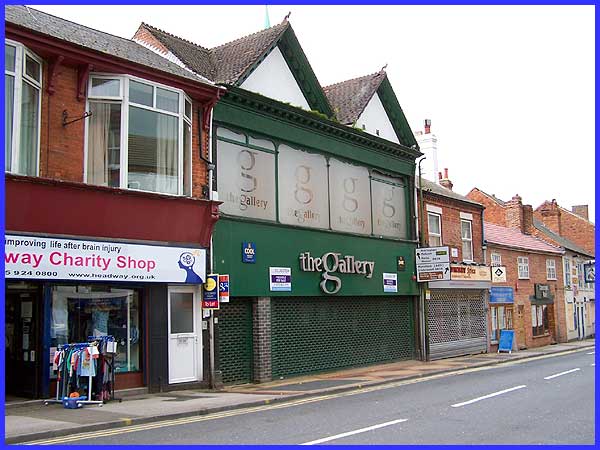
The building next to Bombay Spice currently goes by the name
of The Gallery but for how much longer is uncertain as several
signs indicate it is up for sale or to let. Embedded in the footpath
outside though is the sixth plaque on the Literary Trail which
this time includes a quotation from 'Sons and Lovers': "Paul...
crept up the stone stairs behind the drapery shop at the Co-op,
and peeped in the reading room. Then he looked wistfully out
of the window... The valley was full of corn, brightening in
the sun." I'm not sure whether it is a sign of the recession
or whether I had just visited Eastwood when it was half day closing
or maybe just at the wrong time of day but it seemed that all
of the shops fronting on to the plaques had their shutters down.
The same was true of the Golden Pearl Restaurant on the opposite
side of the road.
|
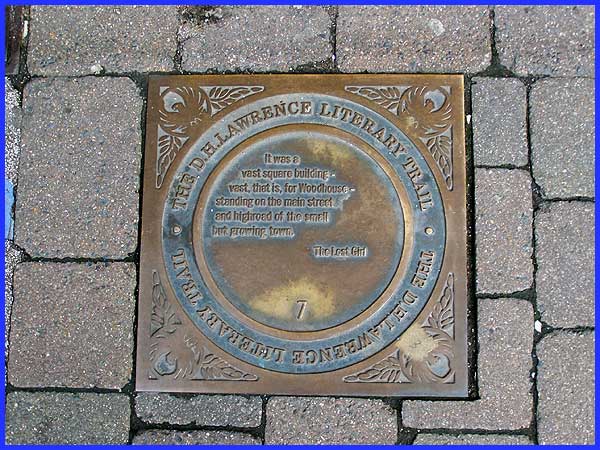
It is outside the Golden Pearl that this seventh plaque with
its quotation from 'The Lost Girl' also sits astride the blue
line. "It was a vast square building - vast, that is,
for Woodhouse - standing on the main street and highroad of the
small but growing town." Bert called the building Manchester
House in the story although in reality it was London House. The
building on the site now (roll your mouse over to see the Golden
Pearl) bears little resemblance to the fine building that once
stood here.
|
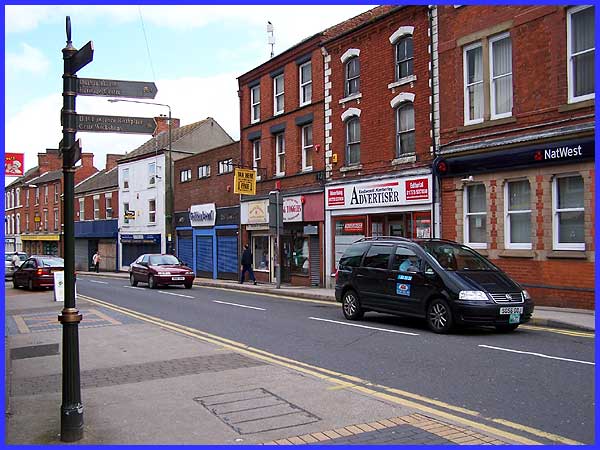
At the initial planning stage of this series I had difficulty
in identifying London House and if you compare the present building
(with the blue shutters) with this 1968 picture at the Picture The Past
website, it will be easy to understand why. So far we have seen
seven of the literary plaques and there are still seven more
to find but for the remainder of this section we will concentrate
on the Blue Line Trail that links many of the locations where
the Lawrence family lived. One of the most important and perhaps
the best known of those locations is his birthplace on Victoria
Street and this signpost on Nottingham Road points the way there.
|
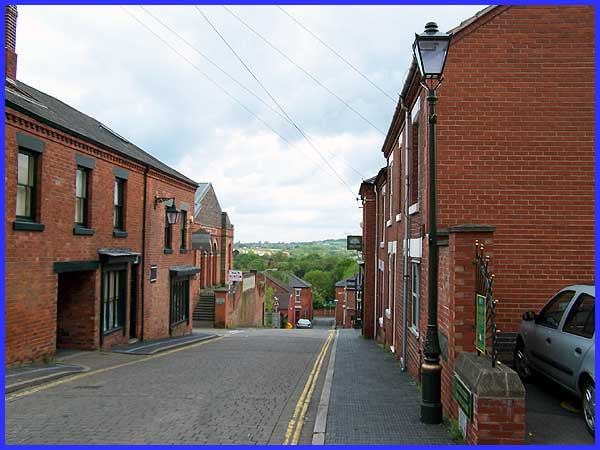
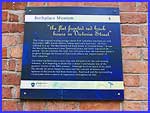 The
contrast between the busy Nottingham Road and the quiet Victoria
Street could not be more startling but as it says in the script
on the blue information board visible on the building on the
left and in close up on the right, "Lawrence was born
into a town that was dictated to by the coal mining industry.
It is inspiring to think that a miner's son became one of the
greatest writers of the 20th century. Although he lived much
of his adult life abroad, he never forgot his roots and the contrast
of beauty and ugliness of the area he had been born into. Eastwood
and the surrounding countryside were a source of inspiration
throughout his life." The
contrast between the busy Nottingham Road and the quiet Victoria
Street could not be more startling but as it says in the script
on the blue information board visible on the building on the
left and in close up on the right, "Lawrence was born
into a town that was dictated to by the coal mining industry.
It is inspiring to think that a miner's son became one of the
greatest writers of the 20th century. Although he lived much
of his adult life abroad, he never forgot his roots and the contrast
of beauty and ugliness of the area he had been born into. Eastwood
and the surrounding countryside were a source of inspiration
throughout his life."
|
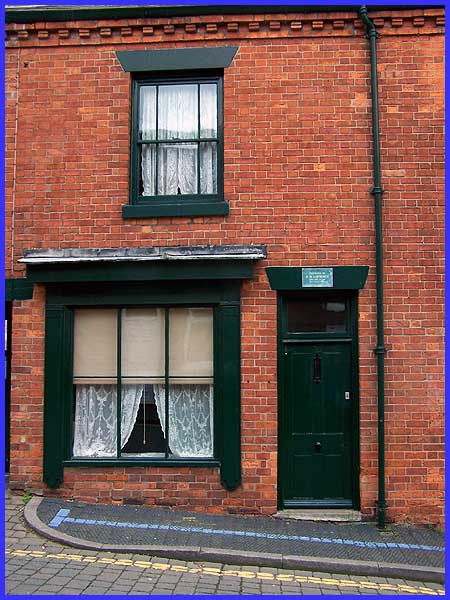
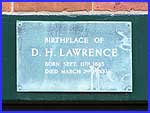 It was
in this "flat fronted red brick house in Victoria Street"
(number 8a) as he later described it, that David Herbert Lawrence
was born on 11th September 1885, the fourth child of coal miner,
Arthur John Lawrence and his wife Lydia (née Beardsall).
Lydia had been born in Manchester although her father was from
Nottinghamshire but when his work took him to Kent she spent
her childhood there resulting in an accent that set her apart
from her Eastwood neighbours. She came from a middle class religious
family, Arthur was working class and their different backgrounds
were a root cause of conflicts in Bert's early life. It was
in this "flat fronted red brick house in Victoria Street"
(number 8a) as he later described it, that David Herbert Lawrence
was born on 11th September 1885, the fourth child of coal miner,
Arthur John Lawrence and his wife Lydia (née Beardsall).
Lydia had been born in Manchester although her father was from
Nottinghamshire but when his work took him to Kent she spent
her childhood there resulting in an accent that set her apart
from her Eastwood neighbours. She came from a middle class religious
family, Arthur was working class and their different backgrounds
were a root cause of conflicts in Bert's early life.
|
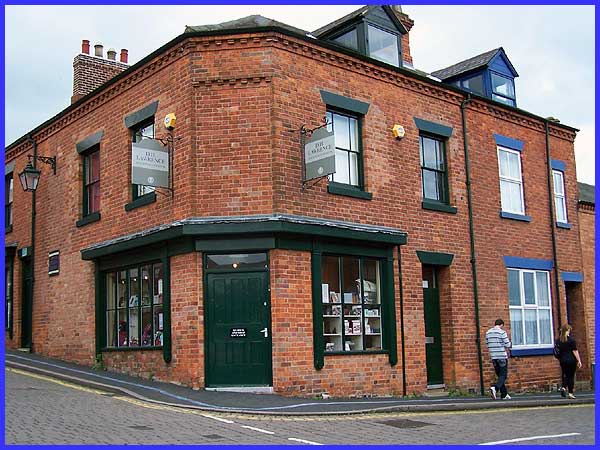
Whilst Arthur was earning himself a reputation as a heavy drinker
Lydia, a former schoolteacher, was responsible for their children's
upbringing and education and deserves credit for Bert's early
literary influence. Beset by poverty, Lydia sold haberdashery
from the Lawrence's front room shop to supplement the family's
income and she dreamed of owning a shop on Nottingham Road. Family
matters though meant that this was to remain a dream but as the
information board states this house on Victoria Street "was
the first of the Lawrence's four Eastwood homes and fairly typical
of the period." It goes on to add that the "family's
progress through the houses of Eastwood reflects the 'improvement'
of their situation." 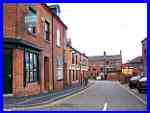 Although the publication of Bert's works
was later to alienate his townsfolk for the way they were portrayed,
he is now recognised as a great writer and his birthplace has
been renovated in the style of the time and turned into a museum. Although the publication of Bert's works
was later to alienate his townsfolk for the way they were portrayed,
he is now recognised as a great writer and his birthplace has
been renovated in the style of the time and turned into a museum.
The blue line continues around the corner along the road on the
right which is Scargill Walk (right) leading past the Craft Workshops
to rejoin Mansfield Road via the archway we saw as an alternative
route to the museum in the previous part of this series.
|

